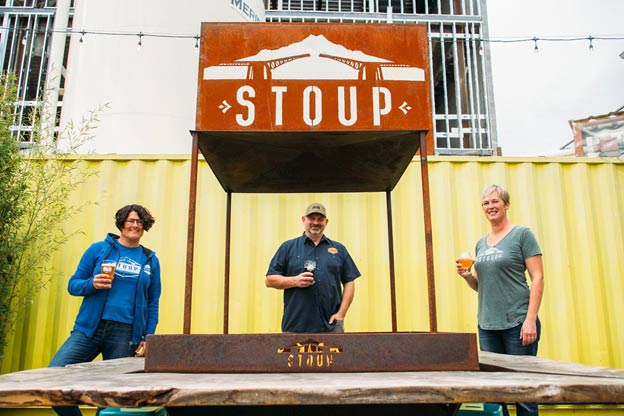This is the first in a series of articles we will publish about the reality of starting a brewery. We may supplement the stories with some podcasts as well. Our goal is to help beer lovers like you understand the effort, risk and finances required to launch a brewery. It’s not as easy as it looks. I think the beer tastes better when you know the real effort that went into making it.
The first installment comes from a guest author and is intentionally timed to coincide with Stoup Brewing’s 5th anniversary party (October 23rd). We are happy to share this story from Holly Regan, a freelance writer and editor and a Seattle native. She specializes in food and beverage writing, both professionally and on her personal blog (www.praiseseitan.com). She has over a decade of experience, and has been published on The New York Times Opinionator and The Huffington Post.
The Grand Beer Bargain: Stoup’s Big Risk Turns Big Reward
Story and photos by Holly Regan
“Can we survive the worst-case scenario?”
This was the terrifying question staring back at Lara Zahaba and Brad Benson in late 2012. The husband-and-wife team behind what would become one of Seattle’s most popular craft breweries was just starting out, needing a loan to turn their dream into reality. The lender wanted just one small thing in return: Everything they had.
Nearly every American dreams of starting his or her own business; and a lot of beer lovers dream of launching their own brewery. But this is the true—if cautionary—tale of what that dream demands. In their case, the couple mustered every penny they could spare. They literally bet the farm: a 150-year-old family farm in Iowa, to be exact.
They were at a crossroads. Were they really prepared to face the worst?
This is how the place you know today, Stoup Brewing, went from pipe dream to plan. And the business’ original name? Critical Juncture Brewing Company. Of course.

Take This Job and Shove It
It all started just over six years ago, when each of them realized their careers weren’t cutting it. They had two young children, and were looking for a more satisfying quality of life for their growing family.
Several years prior, the couple had temporarily moved to the East Coast, so Zahaba could pursue a job with an Italian wine importer. While there, Benson worked as a professional brewer. Throughout more than 20 years together, the couple had shared a passion for craft beer.
Now back in Seattle, Zahaba was working as the marketing and communications director for an Australian wine importer; Benson was a forensic chemist at an environmental laboratory. With Benson’s brewing experience under his belt, and the couple’s desire for change, a question arose: Could beer become a business that would fulfill them both?
“When we were questioning the next step in our lives, we asked ourselves: Why we weren’t doing something we loved?” Zahaba says. The idea of a brewery was born over a series of chats with Brad’s parents; the first business plan drafted on a living room couch.
At the same time, a high-school teacher named Robyn Schumacher had taken her 13-year day job in the public school system and shoved it. Moonlighting as a bartender, slinging tacos and homebrewing in her spare time, she soaked up everything she could about beer—even becoming Washington state’s first female Certified Cicerone®. Schumacher had also dreamed of opening her own brewery, but the task seemed awfully daunting for one ex-public-service employee.

But Schumacher knew Zahaba and Benson through mutual friends, often chatting with Benson about homebrewing over email. Shortly after one providential meeting where Schumacher shared her brewery-owning aspirations with Benson, he reached out and asked if she wanted to become part of their new venture. She eagerly accepted—and Stoup was born.
“I just knew I had to take that plunge,” Schumacher says.
Zahaba also saw only one, albeit rocky, path before them. “I never doubted we could do it. I never doubted our partnership, or Brad’s ability to make good beer,” she says. “We just had to figure out the finances.”
The ABCs of the SBA
There was a lot to figure out.
Diving in, Zahaba and Benson got connected with a small-business mentoring program called SCORE at the federal Small Business Administration (SBA). The program paired them with industry experts, who walked them through processes such as enticing investors and writing a business plan. Their SCORE mentor suggested they get a loan from the SBA in order to finance their hop-fueled dream.
Easy, right? Wrong.
“The SBA loan was probably the hardest part,” Zahaba describes. “The paperwork associated with a small-business loan almost killed Brad, [and the agency] demanded collateral that far exceeded the value of what they were lending to us.”
This brings us to where our story began. The loan required Zahaba and Benson to risk everything they had—and a lot of what Benson’s parents had, as well. This included every last cent of personal money Zahaba, Benson and Schumacher could spare. It included the couple’s home, Benson’s parents’ home and the family farm. To top it all off, Zahaba and Benson cashed in their 401ks and sunk every spare dollar into the venture.
“We eliminated our retirement safety net,” Zahaba says. They now had to ask themselves: Were they prepared if the worst happened?
The laundry list of risks made the list of potential losses equally daunting. All of the cash investments would be gone, with losses of potentially $1 million the couple didn’t have. The SBA loan would have to be paid back, as would a personal guarantee on a property lease—not to mention the family farm. The 401ks were obliterated, and they would have lost their house.
After weighing the options, they determined that the worst-case scenario was taking refuge in a 300-square-foot cabin on Idaho’s Lake Coeur D’Alene, owned by Benson’s parents.
“If we lost everything, we’d have to move the kids and everyone into the cabin,” Zahaba says. “We decided we could live with that risk … so we jumped in with both feet.”
Benson recalls how a friend compared them to 15th-century Spanish explorer Hernán Cortés.
“When he got to the New World with all his men, he burned the ships,” Benson says, making retreat no longer an option. “You just have to push forward … like, we’re here, we’re not going back.”
A Place to Call Home
Of course, they needed a physical space before any actual brewing could begin.
They found one in the young but already-burgeoning Ballard industrial district: home of Seattle craft stalwarts such as Maritime Pacific Brewing Company and Hale’s Ales; and where Reuben’s Brews, Populuxe Brewing and Peddler Brewing Co. had recently opened. It was only a few blocks away from their house. And Benson had chosen it purposefully as a space big enough to grow into, rather than starting small and eventually having to move to another location.

There was just one problem: They couldn’t secure the lease without the SBA loan. And that loan was tied up in months upon months of processing and red tape that Seattle’s small business owners know all too well. So, with each passing day, Benson, Zahaba and Schumacher worried about losing the property their hearts were set on; so much that they’d left no backup option. Once again, they began to sweat—so Benson took matters into his own hands.
“I went to the bank before [our] banker got there, and waited in the parking lot, and when he showed up, I said, ‘We have to talk. Why is this not going through?” Benson recalls. “[The banker] says, ‘I’m not supposed to show you this,’ and he pulls out this massive book. And it’s basically the profit and loss ratios for all industries. He flips through to breweries, and says … ‘You’re too optimistic. That means the SBA thinks you don’t know the industry, and they don’t want to loan the money to you.’”
It was bureaucracy at its finest. Benson was astonished to discover that in order to get the loan, they needed to lose money—at least in their projections, and for multiple years in a row. This was anathema to everything they had been working toward, but what alternative did they have?
“So that’s exactly what we did,” Benson says.”We dumbed our projections down, threw out all our research, artificially inflated costs and deflated revenue—and as soon as we did that, they approved the loan.”
As soon as that happened, “Brad walked back to his job and quit,” Zahaba says proudly.

However, they couldn’t celebrate just yet. Now they had the loan—but they still didn’t have the space. They had given the landlord a letter of intent, and were granted a 30-day period to secure the lease with the proper financing. For every month the SBA loan was held up, they had to deliver another letter of intent, and request another extension.
“They were definitely getting impatient with the process, and losing faith that we were actually going to come through,” Zahaba says. In the end, securing the lease took three agonizing months and extensions.
Further complicating matters were the requirements of the Alcohol and Tobacco Tax and Trade Bureau (TTB), the federal agency which issues permits for U.S. alcohol producers. This permitting process requires background checks from no less than the Federal Bureau of Investigation (FBI). Any infraction on your record—even from childhood, and even if it was expunged—can put your ability to get a permit, and therefore your whole operation, at risk.
They had hoped to open Stoup in the throes of Seattle summer, when sun-hungry patrons throng to patios and beer gardens by the dozens. However, the whole process dragged on from April 2013 until October of the same year: right when the temperatures drop, the crowds dwindle and business slows significantly.
If You Build It, Will They Come?
“Right off the bat, we had to survive the winter,” Zahaba ominously recalls. “The first six months were daunting.”
It seemed to be one hurdle after another. By that point, Benson and Zahaba had depleted their reserves and were paying their mortgage on credit cards. They needed to refinance, and were feeling the pressure of repaying the SBA loan; relieving Benson’s parents of their guarantees; and establishing a line of credit for the brewery, so they didn’t have to drain their cash every time they needed to buy equipment or do an expansion.
But beyond the financial uncertainty, there was an even greater existential risk.
“What if people don’t like what we’re doing?” Benson says. After all, neither Benson, Zahaba nor Schumacher were known in the Seattle professional brewing community.
“We knew people might be skeptical, since we were opening with a 15-barrel brewery when nobody knew who we were,” Zahaba says. Both Zahaba and Schumacher also describe the skepticism their design aesthetic faced. It was important to them to open with a complete and finished space, and to have a warm, inviting vibe that countered the cold, warehouse feel of many brewery taprooms of the day.
“They thought we were all fancy,” adds Zahaba with a smirk.
“People just thought we all had a ton of money,” Schumacher chuckles, as nothing could have been further from the truth.

When You Follow Your Heart, the Risk Is Not Taking One
When the big day for the brewery finally came on Oct. 18, 2013, it marked many turning points in the personal lives of Benson, Zahaba and Schumacher.
It was Zahaba’s birthday; Benson’s was the next day; and Schumacher had gotten married the weekend before. Now they were about to open the doors and share the lifeblood of their dream with the community. They had built it; would the people come?
The people not only came, but turnout was strong from the get-go when they opened to the public on Oct. 23. And it built steadily as the seasons changed from unforgiving winter to the bustling warmth of spring and summer.
It wasn’t all smooth sailing; on opening weekend, Benson says, they “took the worst counterfeit $100 bill.” But now the three chuckle fondly over that memory of petty crime, because their victory has been so great.
“When we saw that first busy Saturday in the taproom, and when we … put a deposit in the bank for the first time—it was pretty exciting,” Zahaba says. As business grew, Benson prioritized paying their debts and freeing them from the SBA loan: a goal they achieved within the first several years.
The journey from the initial crossroads was fraught with uncertainty. But today, both Zahaba and Schumacher describe how they weren’t afraid of taking the plunge, despite the seemingly overpowering odds. After all, what was the alternative? Being stuck forever in an unfulfilling career was no alternative at all.
“I have come to understand … that I really was willing to jump feet-first into this whole venture. I didn’t have any doubt, and I wasn’t afraid of the risk,” Zahaba muses, an impression echoed by Schumacher.

“The honest truth is, it never felt scary to me, because it was so much what I wanted to do,” she says. “It felt more like an opportunity. … I felt really confident in our dynamic. We all really brought something really important to the group.”
Five years after that opening day, there isn’t a Saturday—or a Sunday, or a Tuesday—that goes by that the home Zahaba, Benson and Schumacher’s hearts built isn’t milling with happy patrons.
“All three of us have said, the thing that is most meaningful to us is when we’re sitting in the taproom, and we stop, and look around, and we just see people enjoying our space,” says Zahaba. “They’re in conversation. They’re engaged with one another.”
As they talk, the three exchange knowing smiles, the warmth of nostalgia spreading across their faces; illuminating from their core at the shared remembrance of fond memories hard-won. With even the most trying of times now bathed in the rosy afterglow of sweet success, they are proud of what they’ve created. And they should be.
The official paperwork for the business still says “Critical Juncture.” But one thing is clear: They made the right turn at that crossroads.
“I wouldn’t hesitate to do it again,” Zahaba says with a confident smile.


































Great story! The SBA loan process was the worst experience of my life, more traumatic than anything I have ever been through. Glad to have folks to commiserate with.